There are 21 native types of turtles in Tennessee. These range from vulnerable species like the Bog turtle to aquatic turtles such as Smooth and Spiny Softshells or several subspecies of Map turtles.
In this list we’ll cover each of these 21 species, detailing where they live, what they look like, and a brief overview of how you can keep them in captivity. We’ll also talk about the laws regarding keeping turtles and tortoises in Tennessee.
If you are a Tennessee herpetology enthusiast looking for a native pet turtle, this list should help you to decide which turtle to aim for.
However, before you go trawling through the web to find a captive-bred specimen. Check out our adoptions page to see if you can find the species you are looking for.
With all that said, let’s examine the 21 species of turtles native to Tennessee.
Table of Contents
Turtles in Tennessee
1) Bog Turtle
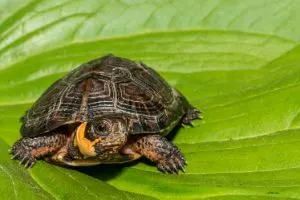
- Experience Level: Beginner
- Family: Emydidae
- Scientific Name: Glyptemys muhlenbergii
- Other Names:
- Adult Size: Between 3 ½ to 5 inches
- Lifespan: Up to 40 years
- Average Price Range: Between $250 and $450 (Illegal in Tennessee)
Also known as Muhlenberg’s turtle, Bog turtles are the smallest turtle species in North America and are confined to a few isolated Northeastern parts of Tennessee.
This terrestrial species is classed as Threatened in Tennessee and cannot be taken from the wild. They are mainly found in bogs, swamps, and other more open wetland habitats.
Bog turtles have keeled shells that range from olive or dark brown to black. Some of the scutes may have yellow or red star-like patterning. Large orange patches mark their cheeks.
As a small species, Bog turtles are easy to house. An enclosure measuring 3-foot by 2-foot is ideal. Provide a soft, loose substrate and plenty of plants for your turtle to root around in, as well as a small pool or bowl of water.
Bog turtles are omnivores and you can feed them insects, worms, mollusks, and commercial pellets along with greens.
For more see our page about the Bog Turtle.
2) Eastern Box Turtle
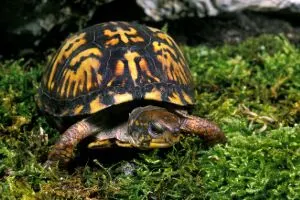
- Experience Level: Beginner
- Family: Emydidae
- Scientific Name: Terrapene carolina carolina
- Other Names: Land turtle
- Adult Size: Between 4 and 7 inches
- Lifespan: Up to 40 years
- Average Price Range: Between $120 and $400
- Recommended Books: Box Turtles: Complete Herp Care (Tess Cook)
The State Reptile of Tennessee, Eastern Box turtles are common to most areas of the state. They prefer woodlands or marshy and grassland areas near streams and ponds.
Eastern Box turtles have high-domed dark brown shells that sport distinctive yellow and orange markings. Their plastrons are also dark brown.
These terrestrial turtles are omnivores and can roam up to 50 meters a day in search of food. In captivity, Eastern Box turtles need at least 70% humidity and can be housed indoors or out.
Eastern Box turtles are a relatively calm species that is unlikely to bite. They can be very active and need a decent amount of space. About 4ft by 4ft is a good size for an enclosure.
For more details, see our page about the Eastern Box Turtle.
3) Three-toed Box Turtle

- Experience Level: Beginner
- Family: Emydidae
- Scientific Name: Terrapene carolina triunguis
- Other Names: Box turtle
- Adult Size: Between 5 and 7 inches
- Lifespan: Between 50 and 100 years
- Average Price Range: Between $250 and $450
- Recommended Books: Box Turtles: Complete Herp Care (Tess Cook)
A subspecies of the Eastern Box turtle, Three-toed Box turtles are found in far southwestern regions of Tennessee. The main habitats for these turtles are woodlands and other grassland areas such as meadows.
Three-toed Box turtles have high domed carapaces which are usually brown or olive. They also have three claws on their hind legs, as their name implies, rather than four.
These omnivorous turtles are mainly terrestrial and roam around on land in search of food. Three-toed Box turtles can be kept indoors or outside, similar to their Eastern cousins. They will need a good amount of space to walk around.
You’ll need to keep their enclosure secure as these small turtles can be easy prey for raccoons and other opportunistic predators.
4) Eastern River Cooter
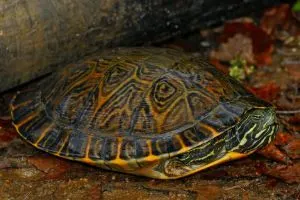
- Experience Level: Beginner to Intermediate
- Family: Emydidae
- Scientific Name: Pseudemys concinna concinna
- Other Names: N/A
- Adult Size: Between 8 and 12 inches
- Lifespan: Between 20 and 40 years
- Average Price Range: $20 to $50
- Recommended Books: Aquatic Turtles: Sliders, Cooters, Painted, and Map Turtles (R.D. Bartlett )
Eastern River Cooters are some of the most common freshwater turtles in Tennessee and are found across the state. They can sometimes be seen basking on rocks or logs at the edge of rivers and streams.
These large turtles have slightly domed shells ranging from brown to dark green. Their shells and heads have yellowish markings and yellow plastrons. Eastern River Cooters can breathe underwater.
Eastern River Cooters are mainly herbivores, preferring to eat vegetation and fruits rather than meat. They will sometimes eat insects.
To house an Eastern River Cooter you’ll need a large tank, probably close to 300-gallons with adequate filtration and UVB light. The water should be around 1 or 2 feet deep, depending on the size of your turtle.
Visit our Eastern River Cooter page for more information.
5) False Map Turtle
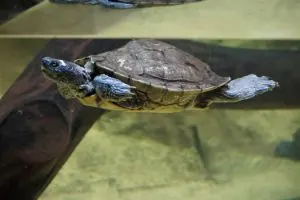
- Experience Level: Beginner
- Family: Emydidae
- Scientific Name: Graptemys pseudogeographica
- Other Names: N/A
- Adult Size: Between 3 ½ and 10 ½ inches
- Lifespan: Between 30 and 50 years
- Average Price Range: Between $6 and $40
False Map turtles are another species of large water turtles in Tennessee, mainly found in northwestern areas in the Mississippi River. They rarely travel far from the water and like to bask on outcrops above the surface.
False Map turtles have dark shells, often brown or black with contour-like yellow markings. As the turtle ages, this pattern gets fainter. Most adults have a pronounced keel on their backs.
To distinguish themselves from other Map turtles, False turtles lack colored patches and markings on their heads. This species is omnivorous and can be fed strips of fish, insects, snails, and worms.
Females will be bigger than males, requiring around a 75-gallon tank while males can be housed in a 40-gallon aquarium. The water should be deep to allow them to swim happily.
For more information, here’s our False Map turtle care guide.
6) Mississippi Map Turtle
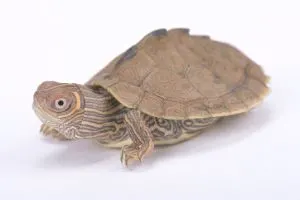
- Experience Level: Beginner
- Family: Emydidae
- Scientific Name: Graptemys pseudogeographica kohnii
- Other Names: N/A
- Adult Size: Between 3 ½ and 10 ½ inches
- Lifespan: Between 30 and 50 years
- Average Price Range: Between $15 and $150
A subspecies of the False Map turtle, Mississippi Map turtles are found in western stretches of the Tennessee River and all along the Mississippi River.
Mississippi Map turtles have dark shells, often brown or black with contour-like yellow markings. Most adults have a series of sharp black-tipped keels running the length of their shells.
When setting up a tank, you’ll need a pretty fast water flow. Males will need a 75-gallon tank, while females need more space in the form of a 125-gallon tank. A land basking area is essential.
Mississippi Map turtles are an aquatic species and rarely travel far from the water. They like to bask on rocks overlooking the surface of the water. They are omnivorous and will eat fish, insects, and leafy greens.
See our Mississippi Map turtle care sheet for more information.
7) Northern Map Turtle

- Experience Level; Beginner
- Family; Emydidae
- Scientific Name; Graptemys geographica
- Other Names: Common Map turtle
- Adult Size; Between 4 and 10 ½ inches
- Lifespan; 15 to 20 years
- Average Price Range; Between $20 and $60
- Where To Buy; turtlestore.com
Northern Map turtles have dark brown or olive green shells with yellow markings that resemble the contours of a map. Small yellow spots behind the eyes differentiate the Northern Map turtle from other subspecies.
Northern Map turtles are one of the most common aquatic turtles in east Tennessee river systems, as well as the Cumberland River in central regions. They like to bask but will rarely venture far from the water.
These turtles are mainly carnivorous and can be fed fish, insects, worms, and commercial turtle diets. Add some leafy greens or lettuce as well.
Male Northern Map turtles are smaller and will be happy in a 75-gallon tank, while females will need around 125-gallons. A good filter system is essential and the water temperature should be in the mid-70s Fahrenheit.
For more information, visit our Northern Map Turtle page.
8) Ouachita Map Turtle
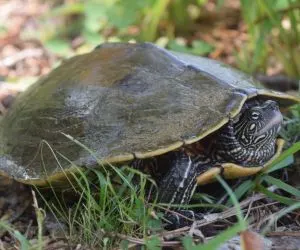
- Experience Level: Beginner
- Family: Emydidae
- Scientific Name: Graptemys ouachitensis
- Other Names: N/A
- Adult Size: 3 ½ to 5 inches for males, 5 to 10 inches for females
- Lifespan: Between 15 and 20 years
- Average Price Range: Between $40 and $100
- Where To Buy: theturtlesource.com
Ouachita Map turtles can be distinguished from other Map turtles by the large lightly colored patches behind their eyes. Males have a prominent keel protruding from their dark green shells.
Ouachita Map turtles are found in Tennessee’s three main rivers; the Cumberland, Mississippi, and Tennessee. They are active during the day, but are easily startled and will jump into the water to hide.
When housing an Ouachita Map turtle, you’ll need an enclosure of about 40-gallons for males and 90-gallons for females with a powerful filtration setup. The water temperature needs to be between 70 and 75 degrees Fahrenheit.
As with many other turtles, Ouachita Map turtles are omnivores. They can eat commercial turtle diets, insects, and worms along with some leafy greens every day.
Check out our Ouachita Map turtle page for more details.
9) Eastern Mud Turtle
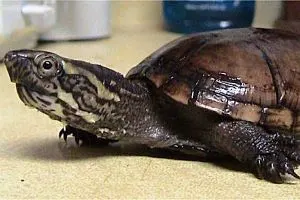
- Experience Level: Beginner
- Family: Kinosternidae
- Scientific Name: Kinosternon subrubrum
- Other Names: Common Mud turtle
- Adult Size: Between 3 and 5 inches
- Lifespan: Up to 50 years
- Average Price Range: $40 to $100
Eastern Mud turtles are found across most of Tennessee except for the upper parts of the Cumberland and Tennessee rivers. They like shallow, slow-moving waters, especially bogs and swamps.
These small turtles have smooth, oval-shaped carapaces that range from brown to yellow. Their shells drop quite sharply at the sides and back.
Eastern Mud turtles are common pet turtles in Tennessee and are pretty easy to care for. A 25 to 40-gallon aquarium is a great size for these guys, with a powerful filter system and water temperature of around 75 degrees Fahrenheit.
Eastern Mud turtles are omnivorous and can mainly eat insects and mollusks such as clams, snails, and worms. You’ll also need to provide some dark greens too. Commercial turtle diets are also a good choice.
For more information, head to our Eastern Mud turtle page.
10) Common Musk Turtle
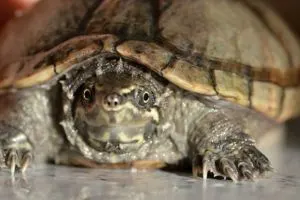
- Experience Level: Intermediate
- Family: Kinosternidae
- Scientific Name: Sternotherus odoratus
- Other Names: Stinkpot, Eastern Musk turtle
- Adult Size: Between 4 and 5 inches
- Lifespan: 50 years and over
- Average Price Range: Between $20 and $90
- Where To Buy: theturtlesource.com, undergroundreptiles.com
Also known as “Stinkpots” thanks to the strong defensive odor they can excrete from their musk glands, Common Musk turtles are found in many regions of Tennessee apart from central and northeastern areas.
Common Musk turtles have dark brown or black unmarked shells. Their heads are also dark, with two yellowish stripes as well as fleshy barbels on their chins and necks.
These tiny turtles prefer marshy and boggy habitats with slow-moving waters. They can be kept in a 20-gallon tank quite happily. Make sure to have a strong filtration setup as these turtles can be pretty messy.
Common Musk turtles are nocturnal omnivores. You can feed them insects and mollusks such as worms. Keep their water temperature somewhere between 72 and 78 degrees Fahrenheit.
Visit our Common Musk turtle page for more information.
11) Stripe-necked Musk Turtle

- Experience Level: Intermediate
- Family: Kinosternidae
- Scientific Name: Sternotherus minor peltifer
- Adult Size: Between 3 and 4 ½ inches
- Lifespan: Over 50 years
- Average Price Range: Between $20 and $60
A subspecies of the Loggerhead Musk turtle, Stripe-necked Musk turtles are small, quick aquatic turtles in east Tennessee. They usually inhabit ponds and rivers as well as wetlands.
These little turtles have shells that range from brown to tan and sport dark spots. Their head and skin are usually brown, with prominent yellowish stripe markings running along the head and neck.
Because of their small size, Stripe-necked Musk turtles can be kept in a 20-gallon aquarium. You’ll need a good filter system to keep the mess to a minimum.
Stripe-necked Musk turtles are omnivores, so feed them insects, mollusks, and some greens. You’ll often see these charismatic turtles strolling along the bottom of their tank.
12) Eastern Painted Turtle
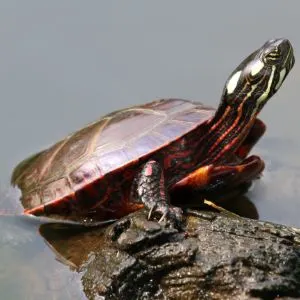
- Experience Level: Beginner
- Family: Emydidae
- Scientific Name: Chrysemys picta
- Other Names: N/A
- Adult Size: Between 4 and 10 inches
- Lifespan: Between 30 and 50 years
- Average Price Range: Between $20 and $50
- Recommended Books: Painted Turtle Pet Owners Guide (Ben Team)
Eastern Painted turtles are small water turtles in Tennessee, mainly found in rivers and streams around the Blue Ridge Mountains. They are common pet turtles in Tennessee.
Eastern Painted turtles have dark shells, often edged in colors ranging from yellow to red. Their faces also have yellow stripes and males have long claws.
For the aquatic habitats needed by this species, a 20 to 40-gallon tank is a great size. You’ll also need to provide a filter as well as UVB light and a basking spot.
Eastern Painted turtles are omnivorous and can be fed insects, mollusks, and greens such as lettuce. Commercial turtle diets can also be given.
For more on their care, diet, and environmental needs, check out our Eastern Painted turtle care sheet.
13) Midland Painted Turtle

- Experience Level: Beginner
- Family: Emydidae
- Scientific Name: Chrysemys picta marginata
- Other Names: N/A
- Adult Size: Between 4 and 10 inches
- Lifespan: Between 30 and 50 years
- Average Price Range: Between $20 and $50
- Recommended Books: Painted Turtle Pet Owners Guide (Ben Team)
Midland Painted turtles are another species of water turtle in Tennessee and are mainly found in streams that diverge from the Tennessee River.
Midland Painted turtles can be distinguished from other members of the subspecies by a dark, shadow-like patch in the center of their plastrons. They have dark shells and are one of the larger types of Painted turtle.
Because of their slightly larger size, Midland Painted turtles need aquariums that measure between 40 and 70-gallons, depending on the size of the turtle. As ever, good filtration and UVB light is a must.
Keep the water temperature above 70 degrees Fahrenheit. As for their diet, Midland Painted turtles are omnivores, and you can feed them commercial turtle pellets, crustaceans, insects, and greens.
Check out our Midland Painted turtle care sheet for more detail.
14) Southern Painted Turtle
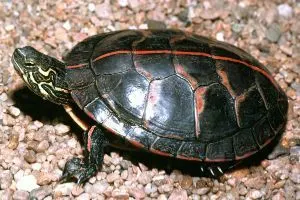
- Experience Level: Beginner
- Family: Emydidae
- Scientific Name: Chrysemys dorsalis
- Other Names:
- Adult Size: Between 5 and 7 inches
- Lifespan: Between 20 and 50 years
- Average Price Range: Between $70 and $140
- Recommended Books: Painted Turtle Pet Owners Guide (Ben Team)
Southern Painted turtles are a subspecies of Painted turtle mainly found in the river and wetland areas of western Tennessee. They prefer slow-moving waters and are the smallest subspecies of the Painted turtle.
Southern Painted turtles have dark brown or black smooth shells and are distinguished from other Painted turtles thanks to the orange or yellow band running down the spine of their carapace.
Due to being smaller, Southern Painted turtles can be housed in 30 or 40-gallon aquariums. However, your turtle may need more space depending on its size. Make sure you have a good filter system in place.
Feed your Southern Painted turtle an omnivorous diet of crickets, worms, turtle pellets, and greens. Keep the water temperature somewhere around 75 degrees Fahrenheit.
For more information, visit our Southern Painted turtle page.
15) Cumberland Slider
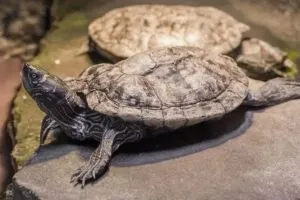
- Experience Level: Beginner
- Family: Emydidae
- Scientific Name: Trachemys scripta troostii
- Other Names: Cumberland turtle, Troost’s turtle
- Adult Size: 7 to 11 ½ inches
- Lifespan: 40 to 50 years
- Average Price Range: $25 to $60
- Where To Buy: theturtlesource.com
- Recommended Books: Aquatic Turtles: Sliders, Cooters, Painted, and Map Turtles (R.D and Patricia Bartlett)
A close relative of both the Red-eared and Yellow-bellied Sliders, Cumberland Sliders are found in the southeastern United States. In Tennessee, they can be found in waters around the Cumberland and Tennessee rivers.
Cumberland Sliders have shells ranging from brown to olive green and have yellow markings. They have yellow stripes behind their eyes.
As a medium-sized aquatic species, male Cumberland Sliders will need a 75-gallon tank, while females will need a larger 125-gallon size. Ensure a good filtration system and water heater if the water temperature regularly falls below 75 degrees Fahrenheit.
Cumberland Sliders are omnivores, meaning that you should feed them insects, mollusks, worms, turtle pellets, and a few dark leafy greens.
For more information, head to our Cumberland Slider page.
16) Red-eared Slider

- Experience Level: Beginner
- Family: Emydidae
- Scientific Name: Trachemys scripta elegans
- Other Names: Water Slider turtle, Red-eared Terrapin
- Adult Size: Between 6 and 8 inches
- Lifespan: Between 20 and 40 years
- Average Price Range: Between $15 and $50
Red-eared Sliders are one of the most popular species of pet turtle. They are a semi-aquatic species mainly inhabiting northwestern river systems in Tennessee. They prefer warm, slow-moving waters such as rivers and lakes.
Red Eared Sliders commonly have an olive green shell, with yellowish striped markings on their scales. Their heads are usually a darker color, with yellow band markings and red patches just behind their eyes.
A 55-gallon tank should be the minimum size for a Red-eared Slider. These turtles are active swimmers and need a lot of space. Providing a powerful filtration system will help keep the tank clean. The water temperature should range somewhere between 76 and 84 degrees Fahrenheit.
Red-eared Sliders should eat an omnivorous diet consisting of turtle pellets, leafy greens, and vegetables.
For more information, check out our complete Red-eared Slider care guide.
17) Yellow-bellied Slider
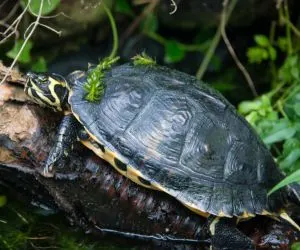
- Experience Level: Beginner
- Family: Emydidae
- Scientific Name: Trachemys scripta scripta
- Other Names: Yellow-bellied turtle
- Adult Size: Between 5 and 12 inches
- Lifespan: Between 20 and 40 years
- Average Price Range: Between $15 and $50
- Recommended Books: Aquatic Turtles – Complete Herp Care (David T. Kirkpatrick )
Yellow-bellied Sliders inhabit southeastern sections of the Tennessee River and favor wetland habitats.
As their name implies, these turtles have yellowish plastrons, as well as yellow markings across their skin. Yellow-bellied Sliders also have prominent yellow patches behind their eyes. Their shells range from dark brown to olive.
Yellow-bellied Sliders are large Sliders and need a tank ranging from 70 to 150-gallons depending on whether you have a male or a female, who will likely be larger. Adequate heating and filtration are essential, and the water temperature should be between 76 and 84 degrees Fahrenheit.
As omnivores, Yellow-bellied Sliders can be fed a diet of commercial turtle pellets, crickets, mealworms, and a large amount of leafy greens.
For a more complete overview, visit our Yellow-bellied Slider care guide.
18) Alligator Snapping Turtle
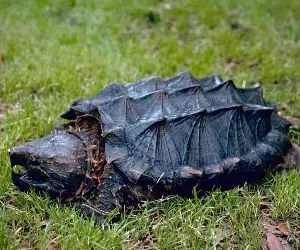
- Experience Level: Intermediate to Expert
- Family: Chelydridae
- Scientific Name: Macroclemys temmincki
- Other Names: Loggerhead Snapper
- Adult Size: Between 15 and 26 inches
- Lifespan: Between 60 and 70 years
- Average Price Range: Between $25 and $60
Alligator Snapping turtles are the largest freshwater turtle species in the world and are instantly recognizable thanks to their ridged, spiked dark brown shells and incredibly strong, beak-like jaws.
These mighty turtles are aquatic and live in deep waters like lakes or rivers, mainly confined to the western regions of Tennessee.
Alligator Snapping turtles are a huge, aggressive species, so you’ll need to be wary of that. They can cause immense pain if they catch you with their beaks or claws, so are suitable only for experienced keepers.
To house these giants, you’ll need a huge stock tank or other enclosure that is kept outside. You’ll probably need around 800-gallons of water. You can also build a pond. You’ll still need to provide filtration as well.
Alligator Snapping turtles are carnivores, and you should feed them mainly on fish. Keeping certain species in your Snapper’s pond can help keep them fed.
To get to grips with Alligator Snapping turtles, check out our complete care guide.
19) Common Snapping Turtle
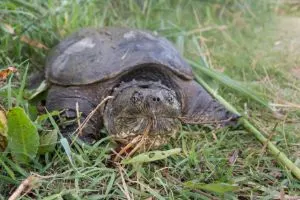
- Experience Level: Intermediate to Expert
- Family: Chelydridae
- Scientific Name: Chelydra serpentina
- Other Names: Common Snapper, Eastern Snapping turtle, Snapper
- Adult Size: Between 8 and 20 inches
- Lifespan: Between 30 and 50 years
- Average Price Range: Between $20 and $40
- Recommended Books: Snapping Turtle Pet Owners Guide (Ben Team)
Common Snapping turtles are a large, freshwater species that are widespread across Tennessee in larger bodies of water. This species is aggressive if handled, and will often hiss and bite. Only tackle a Common Snapper if you’re an experienced keeper.
Common Snapping turtles are easily identified by their distinctive hooked overbites. They usually have dark brown or green ridged shells. They also have strong claws and long tails bearing saw-toothed spines.
To house one of these beasts, you’ll either need a large aquarium, a stock tank, or a pond. Anything from 50 to 300-gallons is a good pick depending on the size of your Snapper. Make sure you have a high-capacity filter, probably on the outside of the tank.
Your Snapping turtle should eat an omnivorous diet consisting of freshwater fish, cooked meats, mealworms, shrimp, and greens and vegetables.
For a more complete overview, check out our Common Snapping turtle care guide.
20) Midland Smooth Softshell Turtle
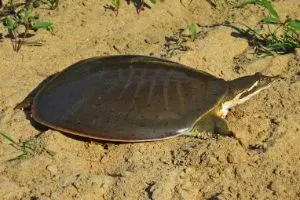
- Experience Level: Intermediate to Expert
- Family: Trionychidae
- Scientific Name: Apalone mutica mutica
- Other Names: Spineless Softshell
- Adult Size: 4 ½ to 7 inches for males, 6 ½ to 14 inches for females
- Lifespan: 25 years and over
- Average Price Range: Between $40 and $60
- Where To Buy: theturtlesource.com
- Recommended Books: Softshell Turtle Pet Owners Guide (Ben Team)
The Midland Smooth Softshell is a subspecies of the Smooth Softshell and is found in Tennessee’s northern counties around major rivers.
Midland Smooth Softshells resemble leathery pancakes, lacking hard shells to protects themselves. They are usually brown or gray, with lines running from behind their eyes and snouts.
Because of their extra vulnerability, Midland Smooth Softshells shouldn’t have any dangerous objects in their tanks that could harm them. Between 75 and 100-gallons should be sufficient for these aquatic turtles.
You’ll need a powerful filter setup due to the need for a sandy substrate in the tank. For their diet, staples should include insects, fish strips, and worms.
21) Eastern Spiny Softshell Turtle
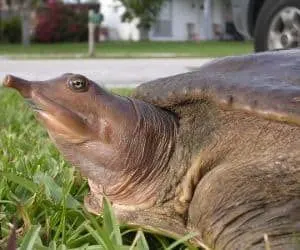
- Experience Level: Intermediate to Expert
- Family: Trionychidae
- Scientific Name: Apalone spinifera spinifera
- Other Names: N/A
- Adult Size: 5 to 9 ½ inches for males, 7 to 17 inches for females
- Lifespan: Between 20 and 50 years
- Average Price Range: Between $70 and $280
- Recommended Books: Softshell Turtle Pet Owners Guide (Ben Team)
Eastern Spiny Softshells are Tennessee’s native subspecies of Spiny Softshell. They are the most common Softshell turtles in Tennessee and are found all across the state.
Eastern Spiny Softshell turtles have a pancake-like shell with dark blotches. Their skin feels a bit like sandpaper. They have long, tapered beaks which they use as snorkels.
Male Eastern Spiny Softshells are about half the size of females and can be kept in a 125-gallon tank. Females are going to need a stock tank or pond. Avoid anything in the tank which could harm your fragile Softshell. Provide a sandy substrate to encourage burrowing.
Their diet should consist of fish, insects, mollusks, and shrimp. A powerful filter setup is necessary for these turtles.
Frequently Asked Questions
Are turtles illegal in Tennessee?
The laws surrounding pet turtles in Tennessee have had a complicated history. Turtles were banned as pets in 2012, but that has since been repealed.
Now, it is legal to own a pet turtle in Tennessee, as long as it has been obtained legally. The state-endangered species is the Bog turtle, which is classed as “Threatened” in Tennessee. Any species of sea turtle is illegal to keep, a ban which covers all of the United States.
When possessing any of Tennessee’s native turtle species, which fall under Class II wildlife, you’ll need to retain documents that detail the name and address of whoever supplied you the turtle as well as a record of the date of acquisition.
You must be able to produce proof of legal ownership for your turtle. Examples include an importation permit or a purchase receipt.
To sell turtles and baby turtles in Tennessee, you will need to procure a commercial fishing license and turtle permit, which you can apply for through the TWRA.
For more information see our guide on turtle laws.
What kind of turtles live in Tennessee?
The list above details the types of turtles living in Tennessee. There are 21 native species overall, mainly consisting of semi and fully aquatic turtles such as Map turtles, Painted turtles, and Snapping turtles.
Most turtles native to Tennessee live in or near major river systems such as the Cumberland, Mississippi, and Tennessee rivers.
Three types of terrestrial turtles live in Tennessee; the Eastern Box turtle, the Three-toed Box turtle, and the state-endangered Bog turtle.
Do tortoises live in Tennessee?
There are no tortoises that are native to Tennessee. However, some wild tortoises could still find their way into areas where they are not native.
The closest tortoise to Tennessee is the Gopher tortoise, which is found in southeastern areas of the United States and is the only type of tortoise native to this wide region.
The Gopher tortoise prefers to keep to pine forests and savannas in states such as Alabama, Georgia, Mississippi, and South Carolina.
Can you have a pet tortoise in Tennessee?
Yes, you can have a pet tortoise in Tennessee. Any species that you keep will be subject to the same laws discussed for turtles above.
It is best to keep tortoises outside if possible, keeping their temperature requirements in mind. Tennessee should have a decent climate for tortoises, but check the needs of your individual species.
Conclusion
And that wraps up our list of the 21 native Tennessee turtle species. For each species, we’ve covered their basic facts as well as details about where you can find them in Tennessee and how you can keep them in captivity.
If you’re looking to obtain one of these types of turtles native to Tennessee, then this list should help you decide which species is right for you.
Alternatively, you can just use this list as a herping field guide when you’re on the lookout for wild turtles in Tennessee.
If you enjoyed this list, then please feel free to leave a comment below!
Other nearby states
- Turtles in Alabama
- Turtles in Arkansas
- Turtles in Georgia
- Turtles in Kentucky
- Turtles in Mississippi
- Turtles in Missouri
- Turtles in North Carolina
- Turtles in Virginia

Meg
Sunday 23rd of July 2023
I found a small turtle in a very shallow (the water is only 1/2” deep at present) tray of water that my ducks use. It’s about 1-1/2” to 1-3/4” long with a tail almost as long and a quite big, broad head. It’s got white markings on its belly. The upper shell is quite ridged and the trailing edge is toothed. Can you tell me what kind of turtle it is and suggest the best type of landscape to relocate it to? I can send photos, if needed.
Tom Evans
Saturday 24th of July 2021
I accidently excavated a nest of turtle eggs. They were half the size of a golf ball. Astounding to me was the number, about 55. We opened a damaged one and it revealed an embrio far enough along that it was definitely a turtle. We live in the edge of the mountains next to the North Carolina border. What kind of turtle might it be? We reburied the eggs by the way.